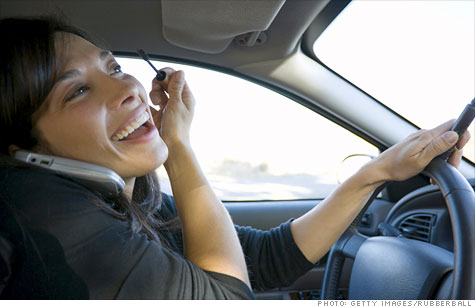
FORTUNE -- Is there anyone over the age of 16 holding a valid license who doesn't believe he is an above-average driver? In a study conducted some time ago, 93% of American students thought their driving skills were better than half of those surveyed -- a mathematical impossibility that has not changed.
Psychologists have a name for it: illusive superiority -- the cognitive bias that causes people to overestimate their positive qualities and underestimate their negative ones. It turns up in classrooms, the workplace, and social situations. Toyota (TM) is out to eradicate it among drivers.
Of course, the Japanese automaker is too polite to even suggest any such thing. But that was the underlying message behind its recent announcement that it would fund 10 new research projects automotive safety with six universities.
While most automotive safety projects -- from crumple zones to air bags -- are centered on the vehicle, Toyota is taking a closer look at the person behind the wheel.
With good reason. Less then two years ago, Toyota's reputation was blackened by a recall crisis that at its height filled the nation's news media with tales of its cars careening wildly out of control and being incapable of being braked. After a thorough investigation by NASA scientists, the only causes attributed to the vehicle were improperly installed floor mats and sticky gas pedals. It turns out, most of the accidents were the result of driver error.
So how do you fix the person behind the wheel? The research being coordinated by Toyota in North America highlights two problem populations -- newly licensed teens and seniors with failing faculties -- and one physiological issue: driver distraction, whether it comes from an electronic device or the person riding in the passenger seat.
Some of the findings are frightening. The Virginia Tech Transportation Institute has been monitoring newly licensed drivers with small video cameras mounted in their cars. They show teens phoning, texting, and applying makeup, oblivious to their surroundings -- and then being jolted into awareness by a collision. One recording shows a distracted young driver being ejected through the driver's side window in an accident. Feeling immortal, teens seem to believe that seatbelts aren't meant for them -- even though they are three times more likely to be involved in a fatal accident than their adult counterparts.
Anybody who has a teen or knows one can list the causes: inexperience, immaturity, night driving, and passenger distraction. It's enough to make you want to raise the driving age to 21.
One solution: Virginia Tech's real-time monitoring provides an opportunity to intervene immediately when it reveals signs of speeding, abrupt lane and speed changes, and drinking. But that's not practical for a large population. Toyota is offering a free two-and-a-half hour hands-on defensive driving program for teens and their parents. Some 90 teens who go through the program will be monitored for the first six months after they get their license to see how effective it is.
Teens aren't the only age group singled out in accident statistics. After a driver turns 75, the frequency of fatal accidents increases dramatically -- twice as often as a 65- to 74-year old. The simple physiological factors of aging are largely to blame: impaired visual function, slowed reflexes, reduced flexibility, and so on.
One area that has attracted researchers from Virginia Tech is "useful field of vision." It turns out that the amount of information a person can take in at a glance grows smaller with age -- by as much as 30%. Previous research indicates that the useful field of vision can be improved through training. Drivers play video games requiring them to identify objects that flash in the periphery of their vision.
VTTI and Toyota are cooperating on a three-year project to test and compare the benefits of brain fitness training to improve field of vision. Seniors will be measured on a variety of driving tasks, including speed modulation, intersection behavior, and lane changes.
One fault common to motorists of all ages is driver distraction. It isn't surprising: Driving is simple and boring much of the time, so drivers do other things while they are behind the wheel. In one study, 54 of 69 crashes were inattention-related.
Toyota has found that talking and listening tasks are much less risky than visually intensive tasks, like operating a navigation system. But while voice controls like MyFord Touch are intended to reduce workload (with mixed results), more needs to be understood about how they function.
So Toyota has also partnered with the MIT AgeLab for a two-year study to explore how the use of in-vehicle command systems affect driver distraction. Among the questions it hopes to answer: How to measure the amount of non-visual demand associated with them, under what conditions they require less demand than traditional methods, and how simple vs. complex interactions affect drivers.
Just in case none of this works, Toyota is covering all its bases. Among other things, it is also working with Wayne State University to develop crash dummies patterned after children and seniors to account for their body differences. The goal is to close the gap between current safety testing and the actual injuries suffered by these two groups in a way that will ultimately reduce injuries to all occupants -- regardless of how old they are. ![]()